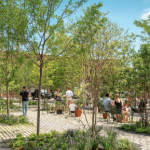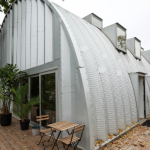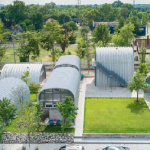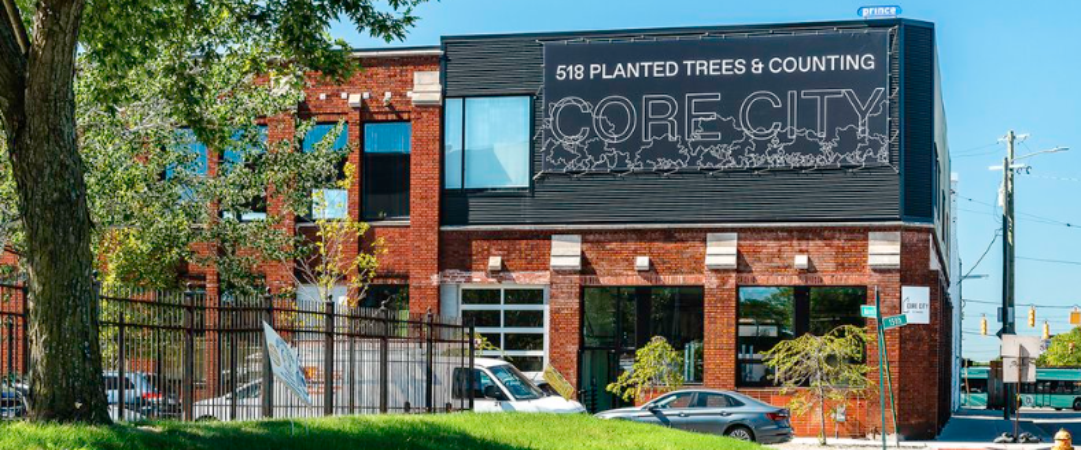One of the newest businesses to set up shop in Core City is DIB – or the Detroit Institute of Bagels – which, not new to the city, had a previous ten-year run in Corktown.
This is the story of an entrepreneur who grew a business that began in his kitchen, won funding through Hatch Detroit, worked for years to build a team that consistently drove to deliver the best product and experience to patrons, started seeing success and planning a significant expansion and then COVID hit.
Owner Ben Newman shuttered the bagel shop temporarily during the initial shutdown period, and tried to pivot and said it was “unrewarding handing bagels to customers out our back door.” With many other factors in play, including some personal commitments, Newman also saw that, “We were not delivering on the experience we wanted to deliver on, so ultimately and with a heavy heart, I decided to close.”

CORE CITY
Three years later though, a new version of DIB has opened in a close-knit, quiet community that’s now also the home of renowned architects and developers and an eclectic mix of companies and brands – Core City.
Core City sits just past the northwest border of Corktown and Woodbridge. Warren Avenue, Grand River Avenue, Martin Luther King Boulevard, and Michigan Avenue are the main thoroughfares in this 4-square-mile neighborhood.
When asked why he decided to reopen after a somewhat devastating 2020, Newman says, “It felt like I had unfinished business.”
When asked why Core City, Newman points to the positive energy of Philip Kafka, founder and president of Prince Concepts, who is heavily injecting his “inspired living” vision and much of his own money including the building DIB is located in.
Now Newman says DIB is “earning the right to do business within the community.”
Overlapping with Newman’s presence and experience to date in Core City is Ishtiaq Rafiuddin, whose architecture firm Undecorated did the interior redesign of DIB, who was brought in by Kafka to design Barda, and the infamous Caterpillar, a single large Quonset ‘hut’ containing eight units that are a mix of residential and live/work spaces. Rafiuddin started his firm in New York City in 2017, but in 2018 he moved to Detroit, and in 2021 he set up both his “shop” and home in Core City in the Caterpillar.

THE CATERPILLAR
When asked why the move he said, “As an architect it became evident that Detroit is a place that doesn’t obey the rules of the market economy for architecture and development, so you have to be really creative to be successful, and I want to be both.” Explaining further he says, “Creativity is needed to provide experience, to be cost-effective and to broadcast a sense of publicness and all of that is in demand and necessary in Core City.”
Rafiuddin is also motivated by Kafka’s work, saying, “Kafka’s vision of public space and landscape and creating inspired living spaces is exceeding my expectations. I also see people visiting the community intentionally to see the unique developments and the way landscape is used – and I think they also see the strong social cohesion.”
Another business owner who relocated from New York City to Detroit’s Fisher building, but recently moved it to Core City is Amani Olu, Founder of marketing and business consultancy, Olu.
He became familiar with the area upon attending a party at a friend’s house there and says he ‘liked the vibe.’ His firm then launched Magnet and then Barda and eventually, he and his business partner and wife Aleiya called Core City their home while renovating another residence.
What draws Olu to Core City, he says, is the architecture, community, green space, and its intentionality.
When it comes to development in New York, there is not a lot of time to be intentional about the work you are doing, you build something as quickly as possible and there isn’t a lot of concern for what went before it, the residents around it or its impact on the community.

QUONSET HUTS
In the end, he says his team is thriving in Core City, and being there has had a positive impact on the company’s culture.
Co-Founder, Creative Chief and CEO of Lafayette American, Toby Barlow launched his creative agency in Core City in 2018, and his word are, “I like to say ‘Core City’s in the middle of nowhere and around the corner from everything.’ To be on the corner of two of Detroit’s most iconic streets and a couple of blocks from two interstates, definitely makes it logically desirable.” He goes on to say, “We loved Phil Kafka’s ideas about space and community and architecture. It’s rare to find a developer with this much imagination.”
Lafayette American was involved in promoting Core City’s Caterpillar, 5K and the park and about the work, he says, “The nice thing about Core City assignments is that they’re all bespoke. These buildings, parks and spaces are different. So you have a pretty simple assignment where your client already has a very cool, very distinctive product. For instance, there’s not a building like Caterpillar in the world. It’s absolutely fantastic. Our job was to reflect and amplify all the unique characteristics of that amazing little building.”
Architect dou Michelle Kleinman and Chelsea Hyduk recently made Core City their home as well – transplanting from New York City – and are planning a multifamily residential community-focused project that puts them in both architect and developer roles.

LAFAYETTE AMERICAN OFFICE SPACE
When asked how the community aspect of Core City is different from other Detroit neighborhoods, Kleinman says,
There are less existing built conditions, infrastructure, and city initiatives in Core City versus some of the other neighborhoods. This means we have to be more creative in thinking about our connectivity – our adjacencies are down the block or even several blocks away, which is a different way of thinking about community engagement.
Do they think Core City could be replicated in other cities? The duo says no. “What exists in Core City is unique to both the place and time. It is something special and made up of people with a shared vision and passion, innovating on ways to move forward based on lessons from both the distant and not-so-distant histories of the city to celebrate our most important value: community.”
As always, be sure to subscribe to our newsletter for regular updates on all things Detroit.






















